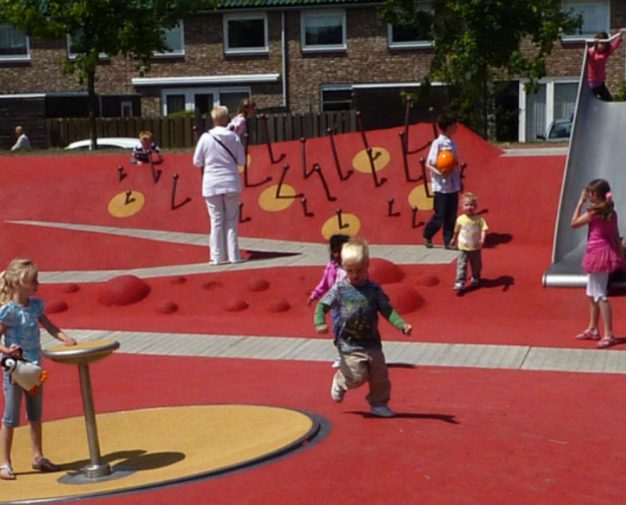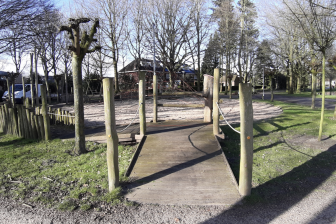
Inclusive design promotes play equality
1 in 20 children aged 14 years old or younger live with a form of disability, either moderate or severe, according to UNICEF. Such figures raise questions as to whether the majority of the existing public play-facilities manage to accommodate the needs of every child and how to successfully design a playground for all.
Are playgrounds designed for everyone?
Due to the fact that definitions of disability research methodologies vary from country to country (and sometime also from time to time), it becomes difficult to calculate the exact representative numbers of mentally or physically disabled children growing up worldwide. Therefore, estimates (including the one above) tend to be dated and essentially speculative. Nevertheless, they are sufficient to illustrate the broad nature and scale of the problem.
These eye-opening statistics compel a re-examination: do projects designed for play meet the needs of every child equally? The unfortunate reality is that a great number of existing playgrounds deny the particular needs of disabled children and limit their creative potential by reproducing the common misconception of what a playground should be: a fenced off public space, fitted with some basic, colourful play equipment.
The “Van Campenvaart” Playground
The ‘Van Campenvaart’ Playground is a playground designed by the carve design studio in the city of Hague, Netherlands. This public project is an exceptional example of a play facility that offers the opportunity for play to all children regardless of ability. “It is a playground where the difference in play between children with and without disabilities is eliminated”, said Carve design studio.
Breaking down the design concept:
- Create ground elevations with an inner play area and provide a path-ramp with accessible inclination. In the “Van Campenvaart” playground:
Elevations manage to vaguely define the space, while at the same time inspiring creative play. The construction of creases between the ramps creates intersecting routes, which allow children with different abilities to meet and help each other.
- Use appropriate materials on the play surface (texture, colour, legislative requirements).
In the “Van Campenvaart” playground:
The carpeting material is “a folded red blanket” that facilitates smooth moving, and rolling while at the same time the bold red colour attracts children’s attention and sparks their imagination for creative play.
- Design tactile elements. In the “Van Campenvaart” playground:
The climbing grips and a number of concave and convex semi-spheres create an environment that promotes imaginary play, urging children to use the equipment in different ways.
- Thoughtful and Creative design of the play equipment. In the “Van Campenvaart” playground:
Play equipment such as the wide slide, the moving rubber mat and the whisper tubes manage to engage children in a variety of play activities.
Inclusive playgrounds for all
The importance of this project lies not only in its design concept – accommodating the activity of play for children with either socially, sensory or motor impairments – but on the brilliant achievement of bringing together children with and without disabilities and essentially helping to eliminate the barriers and distinctions between them. A similar playground, the “Melis Stokepark”, designed also by the carve design studio is located in The Hague and both projects won the Child- and Family Friendly Initiatives Prize in 2011.
Every design project should be perceived as a chance to explore further possibilities and not about defining limitations. Obviously, designing to fulfill the needs of each and every user of a space can be a tremendous challenge, while each project also has specific spatial and financial limitations. Nevertheless, it is immensely valuable to ‘think outside the box’ and seek to develop innovative ideas for designing an appealing space to all users.
Convention on the Rights of the Child, United Nations, Human Rights
Article 23 – paragraph 1 (Children with disabilities):
- “States Parties recognise that a mentally or physically disabled child should enjoy a full and decent life, in conditions, which ensure dignity, promote self-reliance and facilitate the child’s active participation in the community.”
Article 31 – paragraph 1 &2 (Leisure, Play and Culture):
- “States Parties recognise the right of the child to rest and leisure, to engage in play and recreational activities appropriate to the age of the child and to participate freely in cultural life and the arts.”
- “States Parties shall respect and promote the right of the child to participate fully in cultural and artistic life and shall encourage the provision of appropriate and equal opportunities for cultural, artistic, recreational and leisure activity.”
Author: Maria Sitzoglou
Photo and Images by Carve all rights reserved: © Carve
References:
Convention on the Rights of the Child, United Nations, Human Rights.
http://www.unicef.org/sowc2013/files/SWCR2013_ENG_Lo_res_24_Apr_2013.pdf




